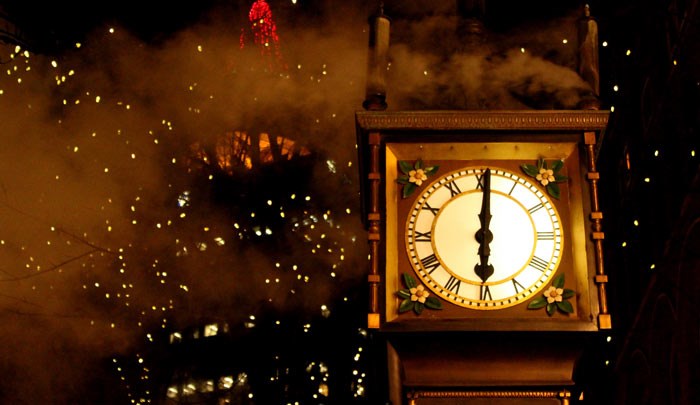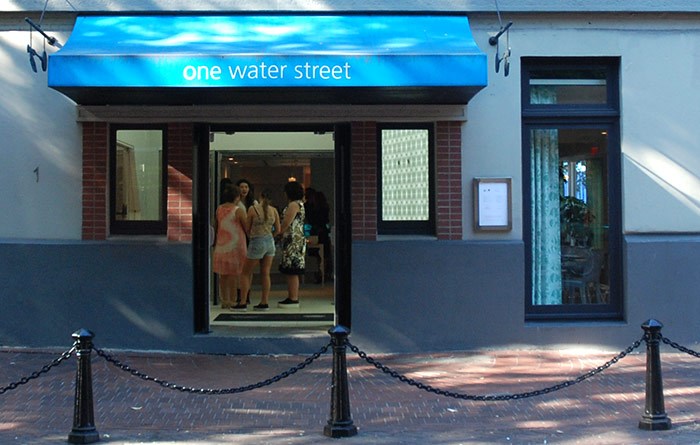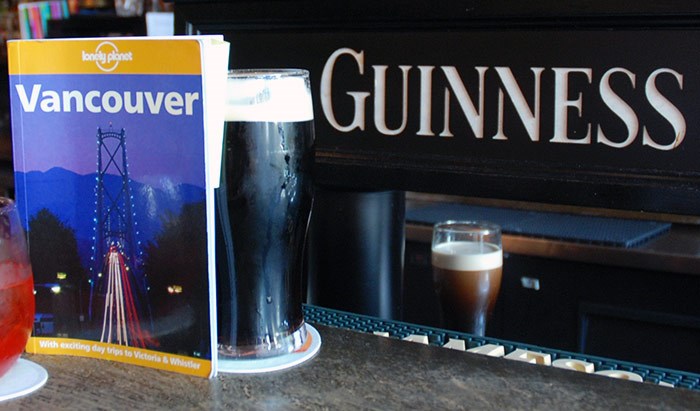We took a 1990âs guide to Â鶹´«Ã½Ó³»sightseeing so we could get a sense of how much the city has changed. Follow this disjointed adventure as it unfolds, or learn more about the series
Gastown
Iâm sorry. Time travel is proving more difficult than I thought, and over the course of the day, my guide and I have become long long-winded, melodramatic, insufferable bores. As I step onto Water Street and into Gastown, itâs obvious I am having some kind of existential breakdown. Whatâs changed here since the 90s? Is it better? Worse? What does it matter?! Iâm dying. Youâre dying. Weâre all dying! Hell, my guide is already dead! And any attempt to catalogue a world thatâs moving at a blinding pace, with or without us, seems ultimately futile.
Suddenly, my mini-meltdown is interrupted by the Gastown steam clock, ushering in 6pm. I hate this goddamn clock! But tonight, something in its baritone chime sounds different, comforting, romantic even. With my guide in hand, I impulsively walk up to it and wrap my arms around its glass spire asÌýit rings in the last chortle of the hour. Flashbulbs from the small audience gathered at the corner of Water and Cambie go off at a paparazzi-like pace. I feel free of theÌýneed to hold onto the past, so I let go. I mean, Iâm probably just drunk from drinking all my guideâs drinks in , but if thereâs anything I am sure of, itâs that this steam clock will be here forever. And in a small way, so will my guide and I â our images captured with the clock by random strangers, instantly stored in the cryptic permanence of cloud archives that belong to all that witnessed this random act of here and now â forever.
 The steam clock, just after striking 6pm.
The steam clock, just after striking 6pm.
âThis is the worldâs first steam-powered clock and, despite its antique appearance, was built in 1977,â my guide says in an attempt to sober the moment with a caution about Gastownâs authenticity, and the validity of our portrait. Its reportage has a business-like tone that symbolically wipes the tears from my eyes, hands me a moist wipe, and gives me a stiff smack on the back that says â letâs get back to work, finish what we started and when weâre done, destroy me so I never have to go through this again. And so our story begins.
Many places operating here in the 90s mirrored Gastownâs origin story. In the 1970s, it was was decaying, and in an attempt to revitalize the area, city planners laid quaint cobblestone streets lit with Victorian lamps, making the area look historic and charming. It lead many a tourist and local alike to believe its antiquity was 100% authentic. The Old Spaghetti Factory, one of the establishments still operating that my guide suggests for dinner, was one of the first restaurants here. Its old-timey knick knacks, endless loaves of free bread, cheap wine, and large tables to gather friends at make it a great spot to experience the remnants of Gastownâs original underpinnings as a museum-like heritage park.
The Managers FAVOURITEÌýat Old Spaghetti Factory:1995:Ìý"About $13"Ìý
2015: $12.40
Nothing in the guideâs dining descriptions captures my imagination like Brotherâs Restaurant, though. Apparently, aspiring actors would often find their way into a robe there as servers.ÌýDiners were entertained with theatre and song while they ate. âWith Gregorian chants emanating from its front door and wait staff dressed in monksâ habits, the âBrothersâ serve items like the Monastery Burger ($8).â As much as Iâd love to revel in Gastownâs campy caricatures of the past, where Brotherâs and Old Spaghetti Factory existed with the converted railway dining car of the The Chew Chew Club on Alexander, magic nights and jazz at Blakeâs on Carrall, and live music at Mickâs Restaurant & Rhythm Bar at 332 Water, they were anomalies. By the 90s, Gastown had begun its evolution into something more contemporary, something entirely its own.
 The former monastery at 1 Water Street that was Brotherâs Restaurant is now The Secret Locaion
The former monastery at 1 Water Street that was Brotherâs Restaurant is now The Secret Locaion
Today, Gastown has fully evolved. The Secret Location, a mash-up of lifestyle boutique and restaurant, has replaced Brotherâs at 1 Water Street, Blacktail entertains with small plates instead of the live music that was found at Mickâs, while Six Acres, The Diamond, Pourhouse, and theÌýRevel Room, have all helped to continue the work Steamworks startedÌýin ushering the craft beer and cocktail eraÌýthat'sÌýcurrently flourishing here.
Drinking in 90s Gastown:Craft beer brewpubs: 1
Craft cocktail lounges: 0
My guide keeps up with its business-like reports, helping to keep us focused on our mission as we step into Gaolers Mews, âthe location of the cityâs first jail, customs house and home to Gastownâs first constable.â Now itâs the apex of dining 2.0 in Gastown. Places like ³¢'´¡²ú²¹³Ù³Ù´Ç¾±°ù±ðâs French influenced West Coast fare, ±Ê±ð°ì¾±²Ô±è²¹³óâs southern BBQ, Cork & Finâs fresh seafood, and just out the lane and into Blood Alley, sits Salt Tasting Room. None of these places are chains. Each is unique unto itself. A refreshing sight after time spent along Robson Street, and in Yaletown. But not as quenching as more alcohol to stave off another episode of anxiety about my own mortality that this journeyÌýseems to be exacerbating.
âGuide,â I say, âletâs party like itâs 1999.â
âClub 212 presents the latest in progressive dance music,â it returns within seconds.
âPerfect!â As we march onto Carrall Street together, expecting to find a raging dance party just after 6pm. It's not much of a surprise when weÌýinsteadÌýfind the Irish Heather at 212 Carrall,Ìýwhich was here in the 90s too, but where L'Abattoire now resides. Surprisingly, neither my guide or I are affected by the sudden change in plans, and we quickly adapt to pubbing over clubbing â why it it remains silent about the Blarney Stone, one of Gastownâs longest running pubs is at once mysterious, yet totally obvious.
 My guide, enjoying a guinness in an unbranded glass.
My guide, enjoying a guinness in an unbranded glass.
âThe Irish Heather not only pours the best Guinness in town - but supposedly sells the second-most pints of the dark stuff in Canada,â my guide says. I check to see if the fact holds true with our bartender as we take a seat at the bar. Indeed, the Irish Heather still runs a close second behind a pub in Whistler when it comes to pouring Guinness. I order 2, stand my guide up on the bar, wrap its pages around one of them, and have a chat with the our server. We talk at length about Club 212, the low income residents that Gastownâs revitalization in the 1970âs displaced further east, and the unavoidable displeasures of change â even with something as trivial as drinking. The addition of a bumpy, embossed harp on the Guinness glass, which had remained unchanged for decades, is a real sore spot for our bartender.
âIt just doesnât feel feckin right. If Guinness forced us to use the their new glass with the harp in it, weâd stop servin' Guinness. Thatâs 'ow strongly we believe in honorin' the past,â my Irish bartender says with confidence while finishing the 2nd pour. If there wasnât a bar separating us, the guide and I would hug him too. Instead, the three of us sit in silence, united by our unbranded, rogue Guinness glasses.
Saved by the clock tower! FindÌýout how the 90s viewed the DTES, and getÌýready to takeÌýyourÌýseat at aÌýdinner table in Chinatown next Thursday.Ìý


